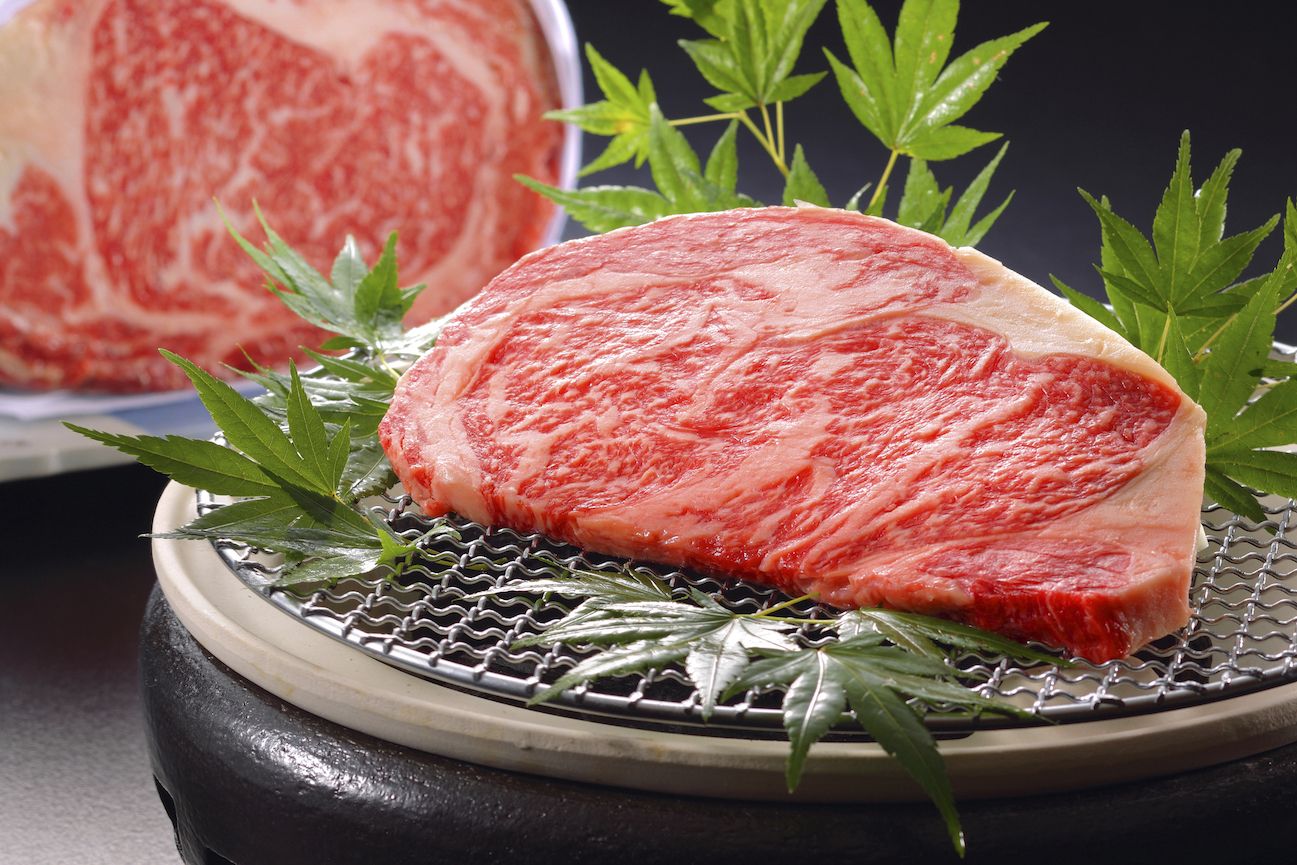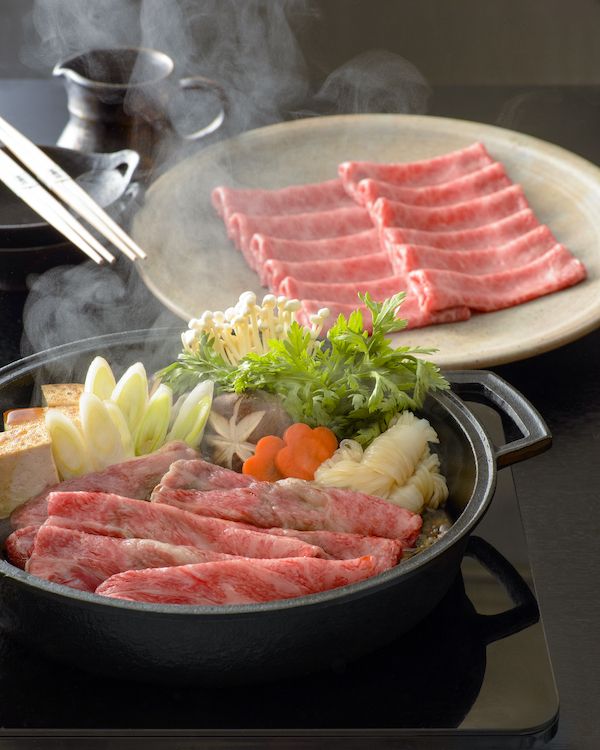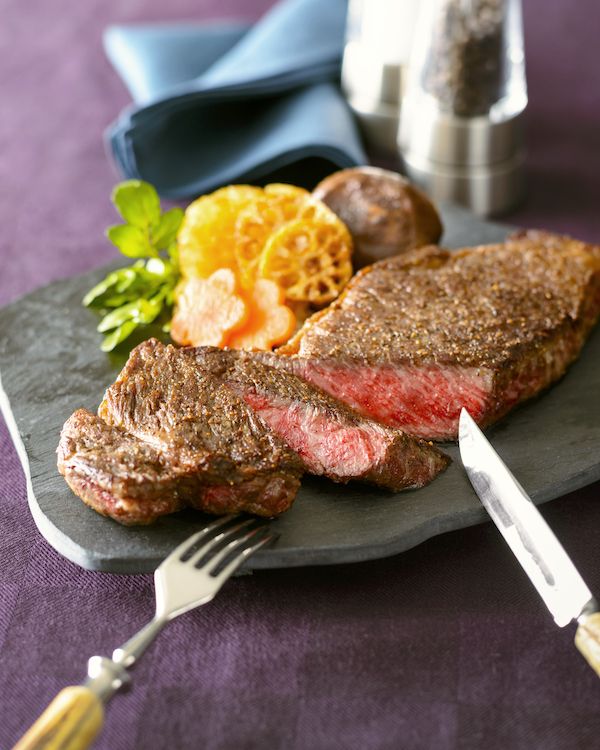
The pride of Japan, Wagyu beef with its concentrated savoriness, delights the world
“Wagyu beef” has become famous across the world for its melting tenderness and juicy savoriness. Beef from breeds local to Japan, and which has undergone a series of breed improvements over a long time, is identified as Wagyu beef. Wagyu beef, with satisfyingly rich “texture”, “taste” and “aroma”, is so popular that it has evoked a “WAGYU” boom, not only in Japan but also overseas, of a deliciousness that distinguishes itself from other beef. The “Universal Wagyu Mark” was established in 2007 to correctly convey Japanese Wagyu beef, and now, Wagyu beef has gathered popularity all over the world.
The secret of the melt-in-the-mouth deliciousness of Wagyu beef lies in its marbling. The white marbling present in the red meat of Wagyu beef contains “Oleic acid”, a fat with low melting point, so it suddenly melts at the body temperature inside the mouth, creating a smooth texture. This flavor must be the greatest feature of thoroughbred Wagyu beef. So what is the secret to nurturing Wagyu beef with high-quality marbling, the essence of it deliciousness?
The general route to nurturing Wagyu beef involves rearing calves from birth to seven to ten months at a commercial farm. Each head of Wagyu beef has its own name, with producers giving them periodic brushing, etc., and rearing them with affection and care. Efforts are also made to provide a pleasant living environment where the cattle will not feel stress. This is also an essential condition for growing good-quality meat.
Depending on their stage of growth, they are given pasture grass, rice straw, etc., as fodder - the key to growing meat. In particular, rice straw, fodder special to Japan, is essential for growing the meat containing marbling, and making the fat white in color, which are characteristics of Wagyu beef. Also, Japan, around 70% of whose land is forest, is surrounded by abundant, seasonal nature, and is blessed with pure water that is essential in the growth of Wagyu beef. In that ideal environment, the Wagyu beef raised rapidly on fresh water and highly nutritional fodder is healthy in mind and body, and boasts superb meat. Japan’s rich climate and nature, as well as the producers’ affection and attention to detail, could be said to be the source of the deliciousness of Wagyu beef.
Another secret of Wagyu beef’s sense of deliciousness is the “Wagyu Beef Aroma” that disperses when inside the mouth. The “Wagyu Beef Aroma”, special to Wagyu, whets the appetite with a deep, sweet fragrance like peach or coconut, which is said to be sensed most strongly when heated to 80 degrees celsius (176 degrees fahrenheit). For example, in Sukiyaki, etc., the “Wagyu Beef Aroma” and rounded texture of the marbling combine to enable full enjoyment of the savoriness special to Wagyu.

Sukiyaki, for experiencing, to one's heart's content, the temptation of Wagyu beef.
Also, Wagyu beef, nurtured from Hokkaido to Okinawa, in all 47 prefectures of Japan, uses methods of rearing to suit the climate and customs of each region, so creating Wagyu beef with the depth of flavor from each. Comparing Wagyu beef with its individual differences such as state of marbling and strength of savoriness, would evoke an appreciation of the depth of Wagyu beef that could not be put in just a few words. Within the famous beef named after places, such as “Matsuzaka beef”, “Kobe beef”, “Hida beef”, is some prestigious, top-class Wagyu beef with rarity value, which is drawing attention not just in Japan, but worldwide as a brand beef ingredient.
Furthermore, Wagyu beef is superior in that all parts are good to eat. “Sirloin” containing high-quality marbling is a delicate meat, with a smooth and melting texture, and sweet and juicy meat juices that fill the mouth. To enjoy its classic flavor to the full, it is best savored simply with just salt and pepper. The recommended grilling is medium rare, at which point the meat juices drip. In Sukiyaki and Shabushabu, delicate and smooth “chuck roll”, with just enough fat content, is often used, and its moderate texture and dense savoriness are its special features. There are many other parts than these which have distinctive tastiness and are tempting, such as “thigh meat”, “boned rib”, “rump meat”.

The lure of Wagyu beef sirloin steak is its tenderness that allows a knife to slip through it, and its depth of flavor.

Parts of beef Each has distinctive features in flavor, and various cooking methods to suit it, too. Photo is from the Ministry of Agriculture, Forestry and Fisheries PR magazine “aff”, September 2020 issue.
In recent years, the word “WAGYU” has become familiar overseas, and exports have increased steadily. The boom for Japan-raised Wagyu beef has spread, so that not only is it served as an upmarket food in Japanese restaurants and the like, but it is also for purchase in upmarket supermarkets, etc. The lure of Wagyu beef, which has captured the world, could be called the gift of a splendid balance of deliciousness and high quality created by careful rearing and a rich environment that are unique to Japan.
Reference: Japan Livestock Products Export Promotion Council “LIVE STOCK JAPAN” website
Photographs supplied by: Japan Livestock Products Export Promotion Council, amanaimages, Ministry of Agriculture, Forestry and Fisheries PR magazine “aff”
Text: Eri Arimoto
[Savoriness]
The sense of taste perceived by humans is classified into five types: sweetness, sourness, saltiness, bitterness and savoriness. The red meat of Wagyu beef contains large amounts of “Inosinic acid” and “Glutamic acid”, the base of its savoriness and depth, as well as “Sweet amino acids” giving sweetness. Through their synergism, a deep, exquisite flavor emerges. Stock, too, the basis of Japanese cuisine, is composed from components of savoriness such as the “Glutamic acid” in konbu seaweed, the “Inosinic acid” in dried bonito, and the “Guanylic acid” in shiitake mushroom, which bring out a depth of flavor.









